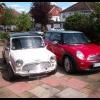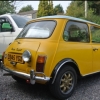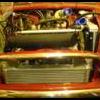I always thought that it was a licencing issue with Buick as in the licence to manufacture only covered Rover cars. Then Morgan got an agreement. Maybe BL wouldn't pay an extra fee for using it in the Stag.
Getting a bit astray here, however that Buick Block / Engine was 'used' by quite a few manufacturers and for a very long time. It must have been a very good design not just from an engineering stand point, but also a production (and cost) side of things too.
The Repco Brabham F1 engine also used these blocks and there was a V6 version too, which I'm not sure if directly related to the V8, but that only very recently ceased production here a few months back. I've had a few cars now with these V6 versions and they are magnificent.
One of the benefits of an alternate A-Series with scope for more displacement earlier during development or a slightly enlarged derivative (in the same way the Ventoux became the Cléon, which in turn became the Energy / E-Type engine) to slot between the A-Series and B-Series would be in allowing BMC to quickly field a 1400-1600cc ADO16 along with similar capacity versions for the Midget and Mini. A 1600cc B-Series for the Mini is obviously out of the question, however while there was the existence of the B-Series powered Austin-Healey Mars prototype it is not known whether a B-Series ADO16 would have been practical beyond a few rumours of experimental prototypes.
Getting back closer to the track! They did fit the E Series to the ADO16 family, which I think you guys called the Maxi (we had them as a Nomad here), 1500 and later 1750 cc, Alloy OHC.
The 1500 CC versions IMO, weren't all that powerful, not a lot better than a 1275, I guess the 1750 versions,, that we didn't get here, would have been considerably better.
There have been a few Mini and Moke conversions done here, that had the 1500 engine and 5 speed gearbox fitted to them. The lack of choice for final drive didn't help, (3.9:1), and with the added weight, we found that the stock 1275 engines cars performed better all round.
![]()




















